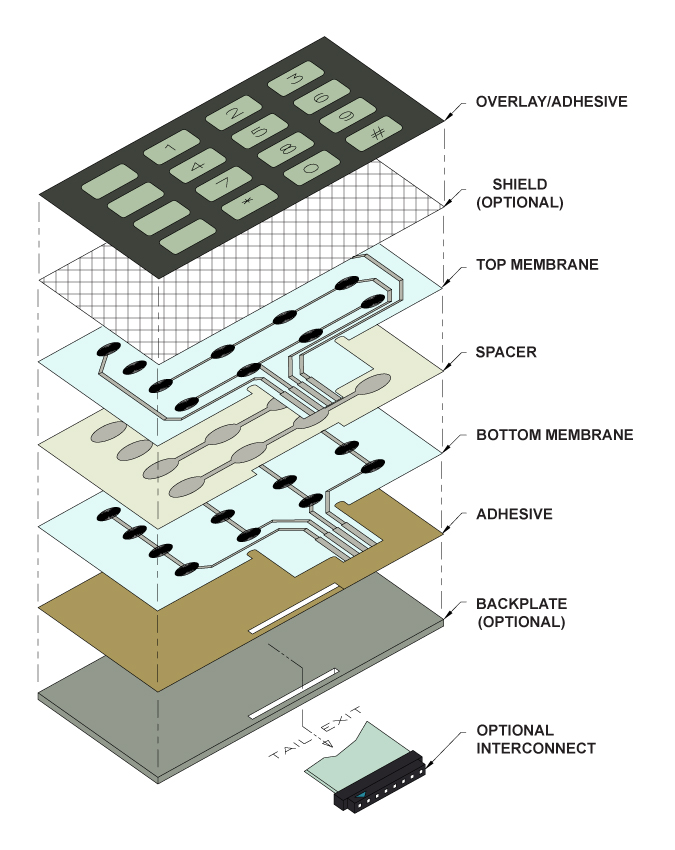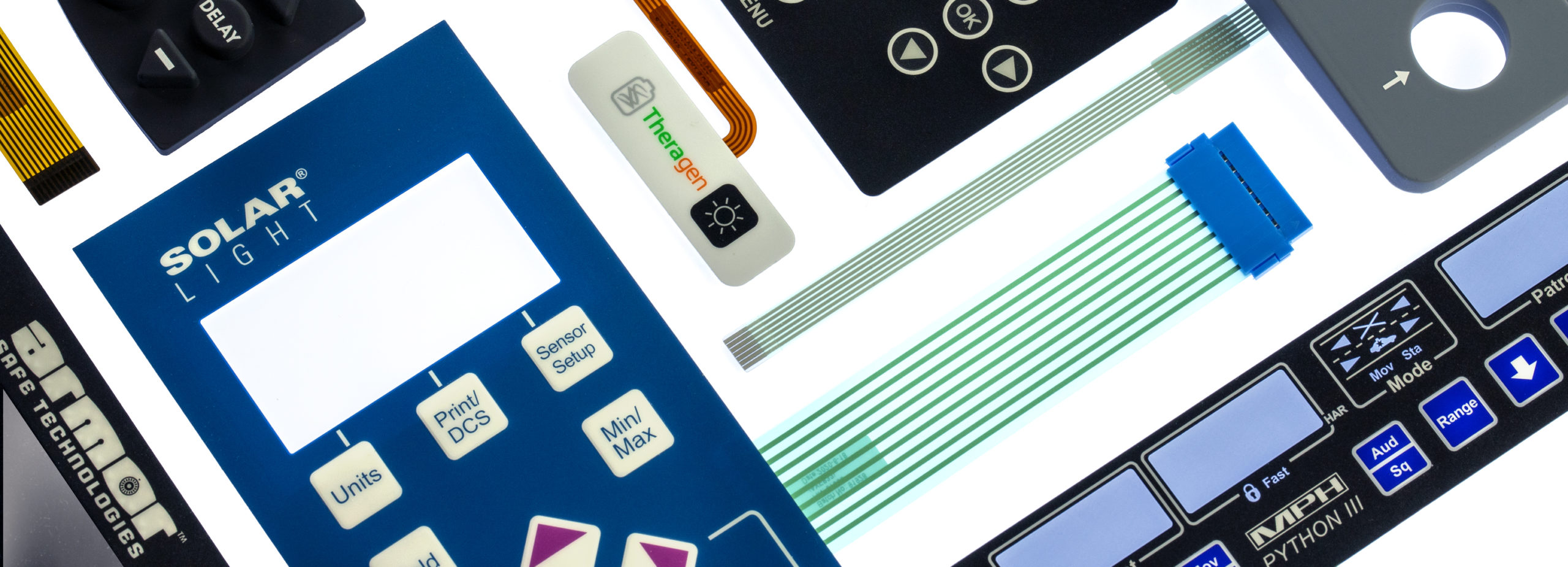Membrane Switches vs. Conventional Switches: What You Need to Know
Membrane Switches vs. Conventional Switches: What You Need to Know
Blog Article
Membrane Switch Innovation: The Key to Dependable and Affordable Interfaces
Membrane layer button innovation has arised as an essential part in the layout of interface, providing both integrity and cost-effectiveness throughout a varied series of applications. Its robust building guarantees resistance to ecological difficulties, while the versatility in style permits customized services that meet specific market demands. As we explore the multifaceted advantages of membrane buttons, their capacity for innovation questions regarding future applications and developing patterns. What does the following phase hold for this modern technology in a progressively electronic landscape?
Understanding Membrane Layer Switch Modern Technology
Membrane layer switch technology is an extensively utilized interface solution in various electronic gadgets, supplying a seamless mix of functionality and style. This innovation includes several layers of materials, typically being composed of a visuals overlay, spacer layer, and a circuit layer. The visuals overlay shows the interface components, while the spacer layer divides the circuit layer from the overlay up until an individual activates a switch.
When stress is related to the overlay, the circuit layer finishes the electric circuit, sending out a signal to the gadget. This system enables different configurations, consisting of responsive comments and backlighting alternatives, enhancing individual communication. Membrane switches are usually produced making use of long lasting materials such as polyester or polycarbonate, making certain durability and resistance to ecological variables like wetness and dirt.
The adaptability of membrane switches allows their application in varied industries, consisting of medical devices, customer electronics, and industrial controls. Their small layout allows for combination right into space-constrained atmospheres, offering a reliable interface without compromising visual appeal. Comprehending the ins and outs of membrane layer button modern technology is important for suppliers and designers seeking to develop reputable and efficient human-machine user interfaces.
Trick Advantages of Membrane Layer Switches
While different user interface options exist, membrane layer switches offer distinctive benefits that make them a preferred selection in many applications. Among the primary benefits is their longevity; membrane layer buttons are designed to endure extreme ecological conditions, including dampness, dust, and temperature variations, making sure resilient efficiency. This strength considerably reduces the requirement for constant replacements, consequently decreasing total upkeep costs.

Additionally, membrane switches are lightweight and compact, making them ideal for applications where room is restricted. Their inconspicuous design contributes to a smooth look without endangering performance.
Cost-effectiveness is likewise a remarkable advantage, as the production process for membrane switches often tends to be cheaper contrasted to standard mechanical buttons. This price, incorporated with their dependability and simplicity of installment, positions membrane layer changes as a useful option for a large range of sectors looking for efficient and efficient interface.
Applications Throughout Different Industries
Just how do membrane switches adjust to the varied demands of various sectors? Membrane button innovation is progressively recognized for its versatility, making it appropriate for a large array of applications across numerous sectors.
In consumer electronic devices, membrane layer switches give a compact remedy for push-button controls and home appliances, enhancing individual experience with user-friendly layout. In addition, the commercial sector leverages membrane layer switches for equipment control panels, taking advantage of their resistance to extreme environments, such as moisture and dust.
Military and aerospace applications also use membrane layer buttons for their dependability and capability to stand up to severe conditions, making certain operational performance in vital circumstances. The food and drink industry adopts these switches for automated systems, where hygiene and simplicity of operation are extremely important (membrane switch). Eventually, membrane switches are tailored to satisfy the unique demands of each market, confirming their vital duty you could look here in modern innovation interfaces
Layout and Customization Alternatives

In the world of membrane switch modern technology, style and customization choices play an essential role in boosting capability and customer interaction. These buttons can be customized to satisfy specific operational needs and aesthetic preferences, making them versatile elements in numerous applications.
Among the main customization options is the design of the button itself, which can be developed to accommodate distinct customer interfaces and ergonomic considerations. By readjusting the shape, dimension, and arrangement of switches, suppliers can develop intuitive layouts that assist in convenience of usage. Additionally, the unification of various colors and graphic overlays permits branding and enhanced visibility, making certain that individuals can swiftly determine functions.
In addition, membrane layer switches can be crafted with different tactile feedback mechanisms, such as raised buttons or audible clicks, to enhance the individual experience. Different materials can also be chosen for resilience and ecological resistance, dealing with aspects such as moisture, temperature fluctuations, and chemical direct exposure.
Eventually, the extensive layout and personalization choices available in membrane layer switch technology empower organizations to produce tailored solutions that not only satisfy useful demands but additionally line up with their branding and functional requirements.

Future Fads in Membrane Buttons
As membrane layer button modern technology proceeds to advance, future patterns are significantly focused on enhancing user experience and integrating innovative functionalities. One significant trend is the combination of touch-sensitive and capacitive technologies into conventional membrane buttons. This advancement enables even more instinctive customer interfaces, providing tactile responses while keeping a smooth style.
An additional arising trend is the usage of eco-friendly products, driven by the growing demand for sustainable production practices. Makers are seeking to decrease their carbon helpful site footprint by utilizing recyclable substrates and low-impact inks, lining up with international sustainability objectives.
In addition, the surge of the Web of Things (IoT) is motivating the incorporation of clever attributes into membrane layer switches. Boosted connection options will enable tools to interact with each other, allowing for seamless integration into broader systems.
In addition, innovations in printing technologies, such as digital printing, are permitting higher design adaptability and modification. This makes it possible for makers to create intricate designs and vibrant colors cost-effectively.

Verdict
In final thought, membrane button innovation stands for a vital technology in customer interface style, using substantial benefits in durability, personalization, and cost-effectiveness. Its widespread applicability throughout diverse sectors underscores its value in contemporary innovation. As advancements remain to emerge, particularly in touch-sensitive user interfaces and lasting products, the potential for membrane changes to boost individual experience and functionality stays click to find out more promising. Proceeded exploration of this technology will likely generate better improvements and widen its range in future applications.
Report this page